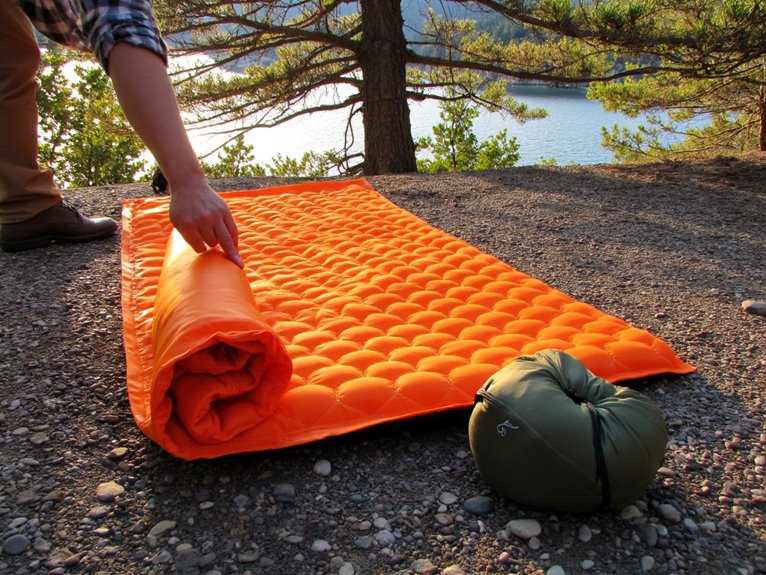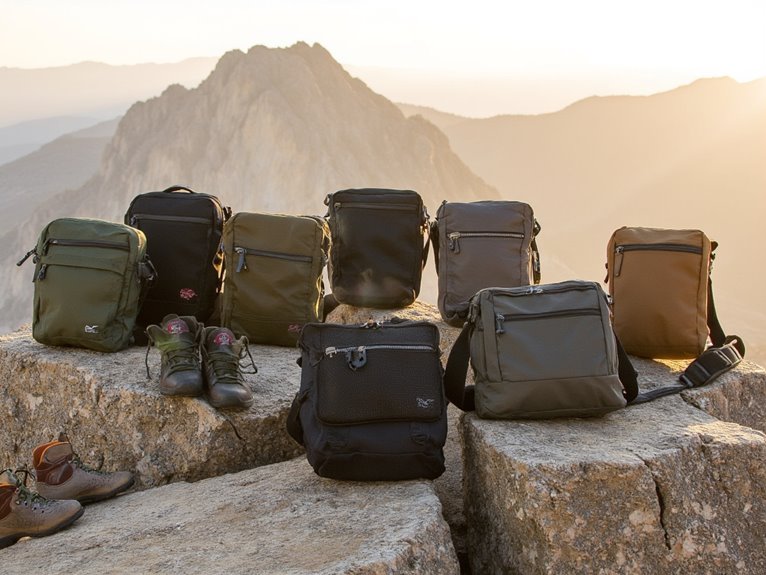How Do Backpackers Pack?
Experienced backpackers pack by mastering the art of minimizing, strategically selecting only the most essential items to facilitate mobility, efficiency, and comfort while on the go. They distinguish between necessities and niceties, prioritizing multi-purpose items and eliminating unnecessary weight. A well-curated backpack is essential, with a focus on functionality over luxury. By adopting an essentials-only approach, backpackers can drastically reduce pack weight and optimize their travel experience. To pack like a pro, it's vital to prioritize, categorize, and carefully select gear – and there's more to learn about how to do it right.
We are supported by our audience. When you purchase through links on our site, we may earn an affiliate commission, at no extra cost for you. Learn more. Last update on 14th December 2025 / Images from Amazon Product Advertising API.
Mastering the Art of Minimizing
When preparing for a trip, mastering the art of minimizing involves strategically selecting only the essentials to include in your backpack, thereby reducing weight, increasing mobility, and enhancing overall travel efficiency.
A well-curated backpack not only alleviates physical strain but also enables travelers to navigate through airports, public transportation, and crowded streets with ease.
To achieve this, it's vital to distinguish between necessities and niceties, prioritizing items that serve multiple purposes.
By doing so, backpackers can optimize their packing list, eliminating unnecessary items that can weigh them down.
Essentials-Only Packing Strategy
A carefully crafted essentials-only packing strategy begins with a ruthless edit of travel necessities, where every item is scrutinized for its utility, versatility, and weight-to-benefit ratio.
This approach prioritizes functionality over comfort and luxury, ensuring that only the most critical items make the cut.
Start by identifying must-haves, such as a first-aid kit, water bottle, and shelter, and then consider multi-tool items that serve multiple purposes.
Be honest about what can be sacrificed, and eliminate items that serve only a single purpose or are redundant.
By adopting an essentials-only approach, backpackers can drastically reduce pack weight, streamline their gear, and optimize their travel experience.
This strategy demands discipline, but the rewards are well worth the effort.
Gear for the Modern Backpacker
Modern backpackers require gear that is both functional and innovative, capable of keeping pace with the demands of travel while also providing a high degree of comfort and convenience.
This includes lightweight and compact sleeping bags, portable power banks for on-the-go charging, and water purification tablets or filters for safe drinking water.
Additionally, modern backpackers often invest in multi-tool knives, compact first-aid kits, and waterproof backpack covers to protect their gear from the elements.
In addition, camping stoves, cooking pots, and collapsible utensils make meal preparation a breeze.
Rolling With the Right Clothes
When packing clothes for a backpacking trip, it's essential to prioritize functionality and practicality.
By focusing on essential items, selecting fabrics that dry quickly, and layering for versatility, backpackers can guarantee they're prepared for any situation.
In the following section, we'll delve into these key considerations in greater detail, providing guidance on how to make the most of your clothing choices.
Pack Essentials Only
Five essential clothing items, carefully selected to provide maximum versatility and comfort, can be mixed and matched to create a wide range of outfits.
These must-haves include a pair of durable hiking pants, a breathable base layer top, a quick-drying shirt, a warm insulating layer, and a waterproof jacket.
By packing only these essentials, backpackers can create multiple outfits for different weather conditions and activities.
For example, the hiking pants can be paired with the breathable top for a casual day hike, or with the insulating layer for colder conditions.
This minimalist approach to packing guarantees that backpackers have the right gear for their adventure without unnecessary weight or bulk.
Choose Quick Dry Fabric
By selecting clothing made from quick-drying fabrics, backpackers can guarantee that their garments dry rapidly, reducing the risk of chafing and discomfort during extended periods of physical activity.
This is particularly vital for backpackers who often find themselves traversing diverse terrains and weather conditions.
Quick-drying fabrics, such as merino wool, polyester, and nylon, allow for efficient moisture wicking, minimizing the likelihood of blisters and skin irritation.
Additionally, these fabrics tend to be lightweight, breathable, and resistant to wrinkles, making them ideal for backpackers who prioritize comfort and practicality.
When choosing quick-drying clothing, look for items with moisture-wicking properties, and opt for garments with a DWR (durable water repellent) finish to boost water resistance.
Layer for Versatility
A well-curated layering system is essential for backpackers, as it enables them to adapt to changing weather conditions and activity levels, ensuring ideal thermal regulation and comfort.
By packing a combination of lightweight, breathable, and moisture-wicking layers, backpackers can fine-tune their attire to suit varying temperatures and activities.
A typical layering system consists of a base layer (moisture-wicking tops and leggings), a mid-layer (fleeces or sweaters), and an outer layer (water-resistant jackets).
This versatile approach allows backpackers to adjust their clothing to suit their needs, whether it's tackling a strenuous hike or relaxing at camp.
Packing the Perfect Toiletry Bag
Organize your toiletry essentials into a compact, easily accessible kit by carefully selecting and categorizing the items you need to pack.
Begin by separating must-haves from nice-to-haves, and prioritize the former. Toothbrush, toothpaste, and any essential medications top the list.
Next, consider personal hygiene items like biodegradable soap, shampoo, conditioner, and toilet paper. Don't forget a travel-sized towel and any specific skincare or haircare products you require.
Pack these items into a water-resistant pouch or bag with multiple compartments to keep everything tidy and within reach.
Remember to check airline regulations for any travel-sized restrictions on liquids and gels.
The Backpacker's Ultimate Checklist
When preparing for a backpacking trip, it's essential to verify that all necessary items are accounted for to avoid last-minute scrambles or, worse, being stranded without vital gear.
A thorough checklist is vital, covering everything from packing essentials to clothing selection.
Packing Essentials
Every backpacker's journey begins with a well-stocked pack, and the following essential items are must-haves for a safe, comfortable, and enjoyable trip.
A reliable water bottle or hydration bladder is vital for staying hydrated on the go.
A portable water purification system, such as a filter or purification tablets, provides access to safe drinking water.
A multi-tool or pocket knife, along with a compact first-aid kit, can help address minor emergencies.
A portable stove or camping cookware allows for meal preparation, while a flashlight or headlamp provides reliable lighting.
Clothing Selection
Selecting the right clothing for your backpacking trip involves a deliberate consideration of factors such as climate, terrain, and personal comfort to guarantee that your garments are both functional and comfortable.
A well-curated wardrobe can make a significant difference in the overall enjoyment of your trip.
When packing clothes, consider the following essential items:
Moisture-wicking base layers for temperature regulation and comfort.
Water-resistant outerwear for protection against wind and rain.
Quick-drying shirts and pants for versatility and convenience.
Insulating layers for cold weather conditions.


